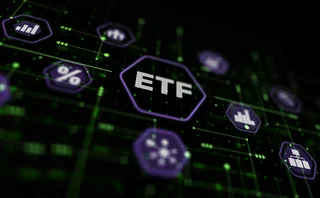A ‘Holo’ Experience: Holographic Interfaces and Innovation
Emilia David ruminates on innovation and how banks can speed up technological evolution in capital markets.

A couple of months ago, I was talking to an executive from a company that specializes in voice-trading technology. Our conversation was mostly about the future of the industry, something that I ruminated on in a feature for the September issue of Waters. As we talked, he mentioned a possibility that now doesn’t seem so far off: the advent of holo trading—holo as in hologram.
It sounded far-fetched. In my head, I imagined holo suites like those in Star Trek, but the more I thought about it, the more I came around to it. It’s interesting and different—and, dare I say it, innovative?
Holo trading won’t happen if no one’s actually thought about doing it from a practical perspective. Innovation is something that should be inherent in banks’ mentalities, but some firms are cutting their research and development departments in order to save costs. It’s understandable, of course, but the speed of technological evolution across the capital markets is staggering.
This is both good and bad. It allows new ideas to be developed and deployed more quickly, but entering into IT quagmires becomes inherently easier. While banks always look to partner with third-party technology providers as a matter of course in order to deploy already-built and tested tools, they are increasingly finding that many of the offerings they evaluate are not targeted enough for their requirements. This is why firms are setting up incubators and accelerators to help foster innovation within the industry, aiming to identify and deploy new tools and technologies that might have a material impact on their day-to-day operations. With this approach, banks are more involved and intimately familiar with new technologies from their conception, so that if and when they are acquired and deployed, their integration is that much more seamless.
Risk, Reward
Holo trading won’t happen if no one’s actually thought about doing it from a practical perspective.
There is little doubt that capital markets-focused incubators and accelerators are a good idea—they provide startups with a safe haven to develop and test their ideas, while also helping them understand how specifically their technologies might impact the industry in a production environment. But they are not without their own set of unique problems. And, given the astonishingly high failure rate among startups—as high as 90 percent—I wonder whether all the hard work is justified. Is it worth spending so much time and money on potential technologies that have an overwhelmingly good chance of failing? Clearly, the answer is yes, which is why there is so much industry talk right now about fintech startups, accelerators and incubators.
But for most, their biggest challenge is deciding when exactly to pull the plug on a startup that they believe will not make the grade. After all, as Eric Ries, the father of the lean startup methodology, argues, startups need to know how to fail quickly and cheaply rather than spending precious time and money on an idea that they know will ultimately fail anyway. Banks need to develop the same discipline so that resources are focused on those ideas most likely to succeed and not squandered on those destined to die on the test bench.
Some startups do succeed and have been assimilated into incubators’ and accelerators’ technology line-ups. Take, for example, Nasdaq’s Trading Insights unit or Deutsche Bank’s commitment to implement 50 ideas from its Innovation Lab by September of this year. While they have their challenges, they are a good way of fostering innovation. If a holographic-trading platform ever comes to fruition, doesn’t it seem logical that it would stem from a bank’s incubator, accelerator or innovation lab?
Personal relationships are important to trading, particularly in exotic and illiquid markets. Traders communicate and often build relationships that ultimately become mutually advantageous in trading. That’s why voice-based trading is still going strong despite so much investment over the years in building cutting-edge trading platforms. My colleague, Dan DeFrancesco, is focusing on virtual reality in the February issue of Waters and how it is starting to make inroads into everyday life, which could open up new opportunities for traders, even if it is in the relatively distant future. Perhaps holo-trading desks don’t seem so far off, after all.
Only users who have a paid subscription or are part of a corporate subscription are able to print or copy content.
To access these options, along with all other subscription benefits, please contact info@waterstechnology.com or view our subscription options here: http://subscriptions.waterstechnology.com/subscribe
You are currently unable to print this content. Please contact info@waterstechnology.com to find out more.
You are currently unable to copy this content. Please contact info@waterstechnology.com to find out more.
Copyright Infopro Digital Limited. All rights reserved.
You may share this content using our article tools. Printing this content is for the sole use of the Authorised User (named subscriber), as outlined in our terms and conditions - https://www.infopro-insight.com/terms-conditions/insight-subscriptions/
If you would like to purchase additional rights please email info@waterstechnology.com
Copyright Infopro Digital Limited. All rights reserved.
You may share this content using our article tools. Copying this content is for the sole use of the Authorised User (named subscriber), as outlined in our terms and conditions - https://www.infopro-insight.com/terms-conditions/insight-subscriptions/
If you would like to purchase additional rights please email info@waterstechnology.com
More on Trading Tech
Symphony boosts Cloud9 voice offerings with AI
The messaging and collaboration platform builds on Cloud9’s capabilities as it embraces the AI wave in what CEO Brad Levy calls “incremental” steps.
Can exchanges leverage new tech to claw back ETF share from RFQ platforms?
Systematic trading strategies and proliferating data are bringing efficiency to an otherwise-fragmented European ETF market.
Nasdaq reshuffles tech divisions post-Adenza
Adenza is now fully integrated into the exchange operator’s ecosystem, bringing opportunities for new business and a fresh perspective on how fintech fits into its strategy.
Liquidnet sees electronic future for gray bond trading
TP Icap’s gray market bond trading unit has more than doubled transactions in the first quarter of 2024.
This Week: HKEx's new derivatives platform; GoldenSource; Quonian-SimCorp, and more
A summary of some of the latest financial technology news.
Chris Edmonds takes the reins at ICE Fixed Income and Data Services
Edmonds is now leading ICE’s fixed income and data business as the rush to provide better data and analytics in fixed income builds.
Systematic tools gain favor in fixed income
Automation is enabling systematic strategies in fixed income that were previously reserved for equities trading. The tech gap between the two may be closing, but differences remain.
Waters Wrap: Examining the changing EMS landscape
After LSEG’s decision to sunset Redi, Anthony examines what might lie ahead for the EMS space.
Most read
- Chris Edmonds takes the reins at ICE Fixed Income and Data Services
- Deutsche Börse democratizes data with Marketplace offering
- Waters Wavelength Podcast: Broadridge’s Joseph Lo on GPTs








